景德镇英文介绍
景德镇导游词英语作文(精选19篇)
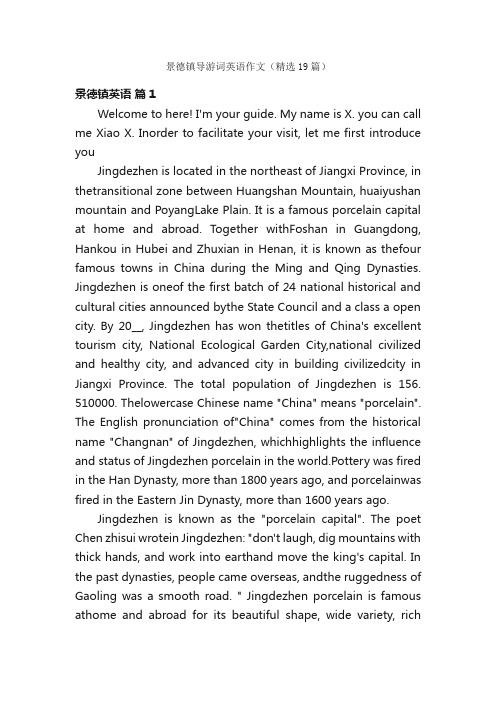
景德镇导游词英语作文(精选19篇)景德镇英语篇1Welcome to here! I'm your guide. My name is X. you can call me Xiao X. Inorder to facilitate your visit, let me first introduce youJingdezhen is located in the northeast of Jiangxi Province, in thetransitional zone between Huangshan Mountain, huaiyushan mountain and PoyangLake Plain. It is a famous porcelain capital at home and abroad. Together withFoshan in Guangdong, Hankou in Hubei and Zhuxian in Henan, it is known as thefour famous towns in China during the Ming and Qing Dynasties. Jingdezhen is oneof the first batch of 24 national historical and cultural cities announced bythe State Council and a class a open city. By 20__, Jingdezhen has won thetitles of China's excellent tourism city, National Ecological Garden City,national civilized and healthy city, and advanced city in building civilizedcity in Jiangxi Province. The total population of Jingdezhen is 156. 510000. Thelowercase Chinese name "China" means "porcelain". The English pronunciation of"China" comes from the historical name "Changnan" of Jingdezhen, whichhighlights the influence and status of Jingdezhen porcelain in the world.Pottery was fired in the Han Dynasty, more than 1800 years ago, and porcelainwas fired in the Eastern Jin Dynasty, more than 1600 years ago.Jingdezhen is known as the "porcelain capital". The poet Chen zhisui wrotein Jingdezhen: "don't laugh, dig mountains with thick hands, and work into earthand move the king's capital. In the past dynasties, people came overseas, andthe ruggedness of Gaoling was a smooth road. " Jingdezhen porcelain is famous athome and abroad for its beautiful shape, wide variety, richdecoration andunique style. Blue and white, Linglong, pastel and colored glaze arecollectively known as the four famous traditional porcelain in Jingdezhen. Thinbodied porcelain is known as a magic treasure, while sculpture porcelain is atraditional Chinese arts and crafts product.景德镇导游词英语作文篇2Distinguished guests, since you just stepped off the plane and arrived inJingdezhen from your busy work, you are the most popular guest in this land.Here, because of your arrival, the air becomes clearer and the scenery becomesmore charming. Because of your participation, our activity is particularlyimportant. I am the leader of this tour group T our guide, my name is Wang, fromthis moment on, we are sincere friends, I very much hope that our team willbecome a very unforgettable trip in your sincere communication with me!The car has started, and Jingdezhen is coming to us. There is a kind ofbreath, a kind of deep culture, a unique charm of the ancient town in the southof the Yangtze River, and a kind of ceramic information distributed everywhere.We will have a short two-hour trip here. As such a small city whose longitudeand latitude are difficult to find on the map, after the Millennium celebration,this city is very beautiful The small town in the south of the Yangtze River isno longer there, with an area of 5247. With a population of 1.52 million and anarea of 9 square kilometers, it is a digital concept. It is more of a platform,a window, a cultural capital and a ceramic city that makes the whole country andeven the world marvel. Jingdezhen got its name from the ceramics fired in 1004ad, that is, during the reign of Jingde of the Song Dynasty, as a tribute.Jingdezhen was called Xinping in Han Dynasty and Changnan in modern times. After1000 years ofdevelopment, Jingdezhen has become a famous city integratingmodern civilization and ancient culture. When it comes to antiquity, we must nottalk about our ceramics, which is our pride. In Jingdezhen, you can see thefamous ceramic products all over the world can be displayed here. Of course, wehave our own unique products. Blue and white, exquisite blue and white, pastel,color glaze are our four top products. The people in the porcelain capital areso enthusiastic, just like the Changjiang River outside the window, which haswitnessed scenes here for thousands of years. Changjiang River belongs to RaoheRiver, one of the five major water systems in Jiangxi Province. It flowseastward to Poyang Lake and finally into the East China Sea. Yangliuyiyi is onboth sides of Changjiang River. The breeze blows. Some historical deposits onthe side make us still vaguely see the prosperity here. Ask the older generationof Jingdezhen and the experts of Jingdezhen Ceramics Museum. He will tell youthat there used to be so many firewood cellars here. In the past, the 5000square meter sky of Changjiang was full of red light, representing more than aprosperous road River water system, silent night, autumn wind is still so crazy,but Changjiang did not sleep, also did not see the rolling water of Changjiang,because he is not really as powerful as the Yangtze River, nor Jinan Daming Lakethat quiet, here you can feel just the red firelight seal, said the two sides ofthe ancient trees crow call. In the early morning, when the sun has not yet comeand the sun is shining, the two sides of the Strait are already bustling. Youshould know that this is an important porcelain port. In the past, there was nobridge, no such convenient land and water transportation network, no Jiujingexpressway, no national highway 206, no convenient train, not to mention thecurrentLuojia airport, with six direct flights to Shanghai, Shenzhen, Beijing,Xiamen, Wuhan and Zhengzhou. Ceramics are the world's best, relying on a largenumber of migrant workers to leave Changjiang and Jingdezhen. We are verygrateful to our ancestors for all their contributions to Jingdezhen. A foreignguest came to Jingdezhen to say that without Changjiang, there would be noceramics. I don't know how much of what he said. At least we should call thisriver, mother river, Jingdezhen's mother river. Now Changjiang has become animportant water transportation channel in Jingdezhen, which can go directly toPoyang Lake, Jiujiang River, and Yangtze River We tell the world everythinghere. Looking at the tall buildings on both sides of the river and the greenfields, I don't know whether the mother river of Jingdezhen is changing orwhether my heart is changing.Jingdezhen has a subtropical climate. It has four distinct seasons, cold inwinter and hot in summer, and abundant rainfall. Because of this, the forestcoverage rate reaches 60,2%, ranking first in the province's three consecutive years of urban airquality assessment. What is lacking here? By the way, our landscape can be seeneverywhere: the logo of Jingdezhen in the city center, Longzhu Pavilion, theCeramic Museum behind the porcelain capital Avenue, and Yaoli, a national 4Ascenic spot in the suburbs.Because of the time, our journey seems to be in such a hurry. In fact, whatI'm telling you is just a little bit of our Jiangnan Town. I'm very sorry.Sincerely hope you will come again next time, thank you!景德镇导游词英语作文篇3Dear touristsHello and welcome to Jingdezhen ancient kiln factory. I'myour guide. Now Iwill use my time on the road to tell you something about ceramics.As the saying goes: people take food as their heaven, and food needsutensils. It can be seen that ceramics are closely related to humancivilization. We humans invented pottery as early as 5000 or 6000 years ago, andporcelain was developed on the basis of pottery. Porcelain is more delicate thanpottery. Smooth. Hard. The firing temperature is also higher. Another point isthat porcelain is made from porcelain ore, while pottery is made from clay.Another explanation of China is that porcelain is as famous as China abroad. Themost representative porcelain is in Jingdezhen, which is known as the capital ofporcelain. Even "Jingdezhen" comes from porcelain. In ancient times, becauseJingdezhen was located in the south of Changjiang River, it was called Changnantown. Later, it was called Xinping town and Fuliang town. It was not until theNorthern Song Dynasty that Zhao Heng, Emperor Zhenzong of the Song Dynasty,decided that Zhongying celadon was imperial porcelain because he saw the placeof origin of the celadon. Every batch of porcelain made by the craftsmen wasdecorated with "Jingde year system", so the imperial court called the place oforigin of this kind of porcelain "Jingdezhen". The porcelain that Jingdezhenpeople are proud of is "blue and white porcelain, exquisite porcelain, pastelporcelain, color glaze and thin body porcelain." They are as white as jade, asbright as a mirror, as loud as a chime, and as thin as paper.Well, now we have come to fulonggang in the West urban area. This ancientbuilding, which is covered by trees, is the ancient kiln porcelain factory weare going to visit today. As far as I know, there is only one such porcelainfactory in the world. Does anyone know why it is called "ancient kiln" porcelainfactory?Because this factory uses the method of Jingdezhen Ming and QingDynasties to make porcelain. The porcelain making process, tools, workshops andkilns are ancient, and the products are mostly antique, so it is called "ancientkiln".Next, please follow me in. Entering this blank room, you can see that theancient porcelain making workshop is composed of four parts: the main room, thechamber, the mud room and the inner courtyard. The main room and the chambermatch in North and south, and they are parallel. The mud room is located in thewest, and the middle is a rectangular inner courtyard. Among them, the main bodyof the green house is the main room, facing south, with sufficient lighting. Allthe workshops for the production of porcelain are completed here. The windlassis the main equipment for the production of porcelain, and the warehouse is theplace for storing raw materials. The mud room is filled with refined mud, andthe inner courtyard is a natural dry place for porcelain. In the middle of theinner courtyard, there is a sun rack pond, which is the most important equipmentin the ancient workshop, and it is very ingenious. Who knows its beauty? Itsbeauty is that the pool and sun pool make use of the space and reduce the landoccupation.Come and see this master. He is putting a ball of mud on the head of thepulley. His hands touch each other. With the rotation of the wheel, the rudimentof a bowl appears. This is called "making billet", commonly known as drawingbillet. Let's see here. The master is concentrating on turning the billet. Thefirst billet is drawn to a certain extent, and then it is cut to meet therequirements with a knife on the pulley car. It is commonly known as "turningbillet" or "cutting billet". Of course, the technological process of the ancientkiln porcelain factory alsoincludes painting porcelain, glazing and enteringthe kiln. Look at these masters painting porcelain here. Let's see how long ittakes to draw a bowl. Yes, it takes only 10 seconds Between, the bowl blank isfull of colorful camellia.Let's go this way. Let's take a look at the kiln house that turns theporcelain body into porcelain. Firing porcelain in the kiln house depends on thepractice of workers, strict labor combination and fine division of labor. Thereis a technical director in the kiln, who is called "master Bozhuang". When itcomes to Ba, Master Zhuang can't talk about T ong Bin. He was a famous master ofbazhuang in Wanli period. He was highly skilled, upright and respected by kilnworkers. At that time, he was ordered to make the extra large blue and whitedragon VAT. Tong Bin and the porcelain workers tried every means to make it, butit failed many times. Seeing that the delivery date was approaching, it was hardto disobey the emperor's orders. For the sake of the life of the porcelainworkers, he jumped into a raging fire at the critical moment of the firingprocess again.Strange to say, it really succeeded this time. People said that it wasbecause Tong Bin showed his spirit. Later, people named him "fenghuoxian". Thisis about the story of Master Zhuang's passing on - Tong Bin jumps in the kiln.Master Ba Zhuang is the chief person in charge of the wood kiln firing process.He is responsible for all kinds of technical problems in the firing process.When the porcelain is ready to be cooked but not yet ripe, the time to stopfiring is the most critical. If the firing time is too long, the porcelain willburn yellow or even fall into the kiln. If the firing time is too short, theporcelain will not be cooked again. At this time, master Ba Zhuang's eyes arecompletely relied on.Ladies and gentlemen, that's the end of today's tour. I hope I can guideyou later. thank you!!景德镇导游词英语作文篇4Welcome to Jingdezhen! I'm your guide. My surname is X. you can call meXiao X. In order to facilitate your visit, let me first introduce you!Jingdezhen has a long history and splendid culture. Located in the south ofthe Yangtze River, it is known as "the most powerful town in the south of theYangtze River". Historically, it is one of the 24 famous historical and culturalcities in China and one of the national class a open cities announced by theState Council, together with Foshan in Guangdong, Hankou in Hubei and Zhuxian inHenan. In June 1953, the Government Affairs Council approved Jingdezhen as acity under the jurisdiction of Jiangxi Province. Now it has jurisdiction overone city, one county and two districts, namely Leping City, Fuliang County,Zhushan district and Changjiang District, with an area of 5256 square kilometersand a population of 1.52 million, of which the urban population is more than400000.Jingdezhen city is located in the northeast of Jiangxi Province, borderingDongzhi County of Anhui Province in the northwest, Wannian County in the south,Boyang County in the west, Qimen County of Anhui Province in the northeast andWuyuan County in the southeast. It is located in the transition zone betweenHuangshan Mountain, huaiyushan mountain and Poyang Lake plain, with eastlongitude of 116 ° 57 ′ - 117 ° 42 ′, north latitude of 28 ° 44 ′ - 29 ° 56 ′.It has subtropical monsoon climate, and has abundant light Full, abundantrainfall, mild and humid, four distinct seasons, overlapping peaks, denserivers, mountains surrounded by water, beautiful scenery. The averagealtitudeof the urban area is 320 meters, the annual average temperature is 17 ° C, andthe annual rainfall is 1763. The annual average sunshine hours is 20__. Eighthours.Jingdezhen is a famous porcelain capital at home and abroad, with a longhistory of porcelain making and profound cultural heritage. According tohistorical records, "the pottery making in Xinping began in the Han Dynasty", itcan be seen that the production of ceramics began as early as the Han Dynasty.In the first year of Jingde of Song Dynasty (1004), the imperial court orderedthe firing of Royal Porcelain here, and the bottom money was signed "Jingde yearsystem", so Jingdezhen got its name. From the Yuan Dynasty to the Ming and QingDynasties, emperors sent people to Jingdezhen to supervise the production ofcourt porcelain, set up porcelain bureaus and imperial kilns, and createdcountless fine ceramics, especially the four famous porcelains of blue andwhite, pastel, exquisite and colored glaze. "Mao Zedong used porcelain",Shanghai "APEC" used porcelain, state guesthouse used porcelain and all kinds ofart ceramics are highly praised by the world. Jingdezhen porcelain enjoys thereputation of "white as jade, thin as paper, sound like a chime, bright as amirror". Mr. Guo Moruo once praised Jingdezhen's splendid ceramic history andculture with the poem of "China is the country of porcelain, and the peak ofporcelain industry is the capital". Ceramics closely linked Jingdezhen with theworld.Jingdezhen has rich connotation and unique advantages in tourism resources.Including ceramic culture, human landscape, ecological environment, especiallyceramic resources have unique advantages. More than 30 historical sites ofceramics have been found in the city, such as the famous place of origin of rawmaterials for porcelain in ancient times and the world-famousplace of kaolin,the ancient kiln site in Hutian, the imperial kiln site in Ming and QingDynasties and so on. They are listed as national and provincial cultural relicsprotection units, which have worldwide influence and attraction.There are many scenic spots and landscapes in Jingdezhen City, includingwell preserved ancient architectural villages of Ming and Qing Dynasties, Huistyle buildings and ancient theatres; Fuliang ancient county yamen, which isknown as the second in China and the first in the south of the Yangtze River;Sanlu temple, an ancient architecture named after Qu Yuan, a Sanlu doctor; Thereare the red pagoda where Zhu Yuanzhang, the song Taizu, hid during the battle,and yangxiantai, Hongyuan fairyland, Taiyang Island, Yueyue lake, Yangfu temple,Liju mountain, Cuiping Lake in Yaoli. Jingdezhen is also an area with gloriousrevolutionary tradition. The famous New Fourth Army Yaoli reorganization is inYaoli town of Fuliang County, and the birthplace of the red ten army is inZhongbu town of Leping City. In 1997, our city was recommended by the NationalTourism Administration and other units as one of the 35 trump spots in China in1997.Jingdezhen has a long history and splendid culture. Located in the south ofthe Yangtze River, it is known as "the most powerful town in the south of theYangtze River". Historically, it is one of the 24 famous historical and culturalcities in China and one of the national class a open cities announced by theState Council, together with Foshan in Guangdong, Hankou in Hubei and Zhuxian inHenan. In June 1953, the Government Affairs Council approved Jingdezhen as acity under the jurisdiction of Jiangxi Province. Now it has jurisdiction overone city, one county and two districts, namely Leping City, Fuliang County,Zhushandistrict and Changjiang District, with an area of 5256 square kilometersand a population of 1.52 million, of which the urban population is more than400000.Jingdezhen city is located in the northeast of Jiangxi Province, borderingDongzhi County of Anhui Province in the northwest, Wannian County in the south,Boyang County in the west, Qimen County of Anhui Province in the northeast andWuyuan County in the southeast. It is located in the transition zone betweenHuangshan Mountain, huaiyushan mountain and Poyang Lake plain, with eastlongitude of 116 ° 57 ′ - 117 ° 42 ′, north latitude of 28 ° 44 ′ - 29 ° 56 ′.It has subtropical monsoon climate, and has abundant light Full, abundantrainfall, mild and humid, four distinct seasons, overlapping peaks, denserivers, mountains surrounded by water, beautiful scenery. The average altitudeof the urban area is 320 meters, the annual average temperature is 17 ° C, andthe annual rainfall is 1763. The annual average sunshine hours is 20__. Eighthours.Jingdezhen is a famous porcelain capital at home and abroad, with a longhistory of porcelain making and profound cultural heritage. According tohistorical records, "the pottery making in Xinping began in the Han Dynasty", itcan be seen that the production of ceramics began as early as the Han Dynasty.In the first year of Jingde of Song Dynasty (1004), the imperial court orderedthe firing of Royal Porcelain here, and the bottom money was signed "Jingde yearsystem", so Jingdezhen got its name. From the Yuan Dynasty to the Ming and QingDynasties, emperors sent people to Jingdezhen to supervise the production ofcourt porcelain, set up porcelain bureaus and imperial kilns, and createdcountless fine ceramics, especially the four famous porcelains of blue andwhite, pastel, exquisite and colored glaze."Mao Zedong used porcelain",Shanghai "APEC" used porcelain, state guesthouse used porcelain and all kinds ofart ceramics are highly praised by the world. Jingdezhen porcelain enjoys thereputation of "white as jade, thin as paper, sound like a chime, bright as amirror". Mr. Guo Moruo once praised Jingdezhen's splendid ceramic history andculture with the poem of "China is the country of porcelain, and the peak ofporcelain industry is the capital". Ceramics closely linked Jingdezhen with theworld.Jingdezhen has rich connotation and unique advantages in tourism resources.Including ceramic culture, human landscape, ecological environment, especiallyceramic resources have unique advantages. More than 30 historical sites ofceramics have been found in the city, such as the famous place of origin of rawmaterials for porcelain in ancient times and the world-famous place of kaolin,the ancient kiln site in Hutian, the imperial kiln site in Ming and QingDynasties and so on. They are listed as national and provincial cultural relicsprotection units, which have worldwide influence and attraction.There are many scenic spots and landscapes in Jingdezhen City, includingwell preserved ancient architectural villages of Ming and Qing Dynasties, Huistyle buildings and ancient theatres; Fuliang ancient county yamen, which isknown as the second in China and the first in the south of the Yangtze River;Sanlu temple, an ancient architecture named after Qu Yuan, a Sanlu doctor; Thereare the red pagoda where Zhu Yuanzhang, the song Taizu, hid during the battle,and yangxiantai, Hongyuan fairyland, Taiyang Island, Yueyue lake, Yangfu temple,Liju mountain, Cuiping Lake in Yaoli. Jingdezhen is also an area with gloriousrevolutionary tradition. The famous New Fourth Army Yaoli reorganization is inYaoli town of Fuliang County, and thebirthplace of the red ten army is inZhongbu town of Leping City. In 1997, our city was recommended by the NationalTourism Administration and other units as one of the 35 trump spots in China in1997.景德镇导游词英语作文篇5Hello, everyone. I'm _ _ and welcome to Jingdezhen, the Millenniumporcelain capital.Jingdezhen is located in the northeast of Jiangxi Province, bordering Anhuiin the north and Shangrao in the southeast and West. The terrain is high, mediumand low, and it looks like a basin. There are Changjiang River and Le'an River.It has a total area of more than 5200 square kilometers and a total populationof about 1.56 million. When you first listen to "Jingdezhen city", you may feelvery strange. On the one hand, it is "city" and on the other hand, it is "town"Why? Because Jingdezhen was just a small town at first, named Changnan. In theSong Dynasty, it was famous for porcelain firing. In the first year of ZhaoHeng's reign, Jingdezhen was renamed "Jingdezhen" by the emperor's name. Afterthe founding of new China, Jingdezhen was upgraded to a provincial city with theapproval of the State Council. Considering the continuation of the famousporcelain city, the word "Zhen" was not removed.Jingdezhen is called the capital of porcelain. Of course, the porcelainhere is the most famous. Numerous fine ceramics have been created here,especially the four famous porcelains of blue and white, famille rose, exquisiteand colored glaze, which enjoy the reputation of "white as jade, thin as paper,bright as mirror, and sound as abundant".It turns out that Jingdezhen still has such a true story. There is a kilnman named Tong Bin who sacrificed himself to porcelainin order to save the kilnworkers. He jumped into the red burning kiln. A few days later, when the kilnwas opened, all the porcelains were fired. They were as white as jade, and allof them were upright. In memory of this dedicated kiln master, the pottersburied his ashes on Fenghuang Mountain in the town, built a temple for him,molded a statue, and honored him as the "master of wind and fire". There aremany scenic spots in Jingdezhen, including ceramic history exhibition area,Gaoling Yaoli scenic area, Fuliang ancient county yamen, Hongyan fairylandscenic area, etc.Now I'd like to introduce the ancient county yamen in Fuliang. The countyyamen was first built in the 11th year of the Yuan Dynasty and has a history ofmore than 1000 years. What is preserved now is rebuilt in the reign of Daoguangin the Qing Dynasty. There is a middle gate in front of the county government. Aroad made of feldspar leads directly to the gate. The stone slab in thecourtyard is paved and several ancient cypresses are planted next to it. Thereare five rooms in the lobby, and each garden gate is set behind the lobby. Thedesign of the whole yamen gives people the feeling that solemnity and easecoexist, that massiness and elegance mingle, and that it is very artistic.Of course, you can also taste fried wonton, dumpling rake, cold powder,soda rake and other famous snacks here. I'm _ _ and wish you a pleasantjourney.景德镇导游词英语作文篇6据史书记载,自唐代开始,瑶里人就依山筑窑、伐木为薪,烧制陶器了。
景德镇介绍(英文版)
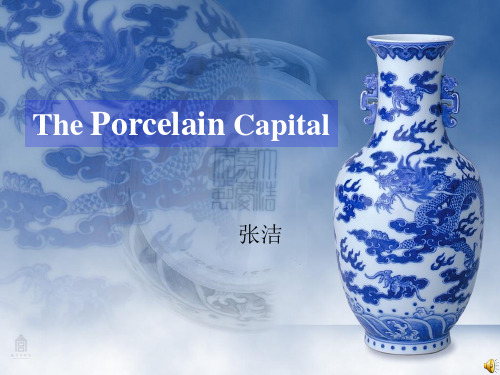
Porcelain
Species: Blue and white porcelain Colored glaze porcelain Colorful famile - rose porcelain Exquisite porcelain Thin tire porcelain Sculpture porcelain
Climate
Jingdezhen has a four-season, monsoon-influenced, humid subtropical climate, with somewhat brief, cool and damp winters, and long, very hot and humid summers.
The Porcelain Capital
张洁
The main content
• Jingdezhen City • Porcelain
Jingdezhen
• A town in the past
• A well-documented history stretching
back over 2000 years
Characteristics
as as as as thin as paper white as jade bright as a mirror sound as a bell
How to make porcelain
1.Select clay with high viscosity, the best is kaolin 2.Mix clay and water, select the fine mud 3.Make ceramic-type tires 4.Dry tires in the shade 5.Trim tires to make them smooth with tools 6.Draw pictures and glazed 7.Roast tires
英语六级翻译新题型训练之景德镇瓷器
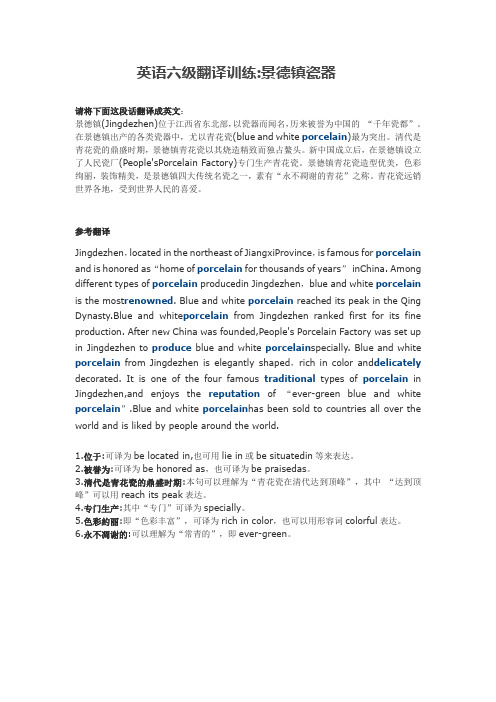
英语六级翻译训练:景德镇瓷器请将下面这段话翻译成英文:景德镇(Jingdezhen)位于江西省东北部,以瓷器而闻名,历来被誉为中国的“千年瓷都”。
在景德镇出产的各类瓷器中,尤以青花瓷(blue and white porcelain)最为突出。
清代是青花瓷的鼎盛时期,景德镇青花瓷以其烧造精致而独占鳌头。
新中国成立后,在景德镇设立了人民瓷厂(People'sPorcelain Factory)专门生产青花瓷。
景德镇青花瓷造型优美,色彩绚丽,装饰精美,是景德镇四大传统名瓷之一,素有“永不凋谢的青花”之称。
青花瓷远销世界各地,受到世界人民的喜爱。
参考翻译Jingdezhen,located in the northeast of JiangxiProvince,is famous for porcelain and is honored as“home of porcelain for thousands of years” inChina. Among different types of porcelain producedin Jingdezhen,blue and white porcelain is the most renowned. Blue and white porcelain reached its peak in the Qing Dynasty.Blue and white porcelain from Jingdezhen ranked first for its fine production. After new China was founded,People's Porcelain Factory was set up in Jingdezhen to produce blue and white porcelain specially. Blue and white porcelain from Jingdezhen is elegantly shaped,rich in color and delicately decorated. It is one of the four famous traditional types of porcelain in Jingdezhen,and enjoys the reputation of “ever-green blue and white porcelain”.Blue and white porcelain has been sold to countries all over the world and is liked by people around the world.1.位于:可译为be located in,也可用lie in或be situatedin等来表达。
的江西景德镇英文导游词5
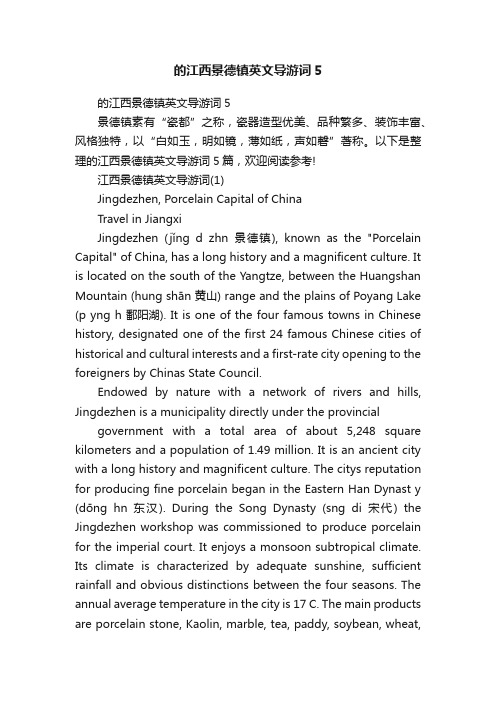
的江西景德镇英文导游词5的江西景德镇英文导游词5景德镇素有“瓷都”之称,瓷器造型优美、品种繁多、装饰丰富、风格独特,以“白如玉,明如镜,薄如纸,声如磬”著称。
以下是整理的江西景德镇英文导游词5篇,欢迎阅读参考!江西景德镇英文导游词(1)Jingdezhen, Porcelain Capital of ChinaTravel in JiangxiJingdezhen (jǐng d zhn 景德镇), known as the "Porcelain Capital" of China, has a long history and a magnificent culture. It is located on the south of the Yangtze, between the Huangshan Mountain (hung shān 黄山) range and the plains of Poyang Lake (p yng h 鄱阳湖). It is one of the four famous towns in Chinese history, designated one of the first 24 famous Chinese cities of historical and cultural interests and a first-rate city opening to the foreigners by Chinas State Council.Endowed by nature with a network of rivers and hills, Jingdezhen is a municipality directly under the provincial government with a total area of about 5,248 square kilometers and a population of 1.49 million. It is an ancient city with a long history and magnificent culture. The citys reputation for producing fine porcelain began in the Eastern Han Dynast y (dōng hn 东汉). During the Song Dynasty (sng di 宋代) the Jingdezhen workshop was commissioned to produce porcelain for the imperial court. It enjoys a monsoon subtropical climate. Its climate is characterized by adequate sunshine, sufficient rainfall and obvious distinctions between the four seasons. The annual average temperature in the city is 17 C. The main products are porcelain stone, Kaolin, marble, tea, paddy, soybean, wheat,peanut, rapeseed etc.Since the period of Han Dynasty (hn di 汉代), Jingdezhen has had the ceramic industry. Up to now, it has more than 2000 years of history. Traditionally, Jingdezhen was titled Ceramic Capital. Porcelain of Jingdezhen has a beautiful shape, various types, rich decorations and unique styles. It is worldwide famous for its color as white jade, brightness as bright mirror, thinness as paper and sound as music. Qinghua Porcelain (qīng huā 青花), Linglong Porcelain (lng lng 玲珑), Fencai Porcelain (fěn cǎi 粉彩) and Seyou Porcelain (s yu 色釉) altogether are called Four Traditionally Famous Porcelains in Jingdezhen.1. Ancient Porcelain Street (gǔ di c q jiē 古代瓷器街) It is in the center of Jingdezhen. It was the most busy and bustling street in the late Ming (mng di 明代) and early Qing Dynasties (qīng di 清代), now renowned for its long history and beautiful traditions that come from its ancient culture. The street is composed of three parts, each of which fully reflects its prosperous past. Exquisitely designed and decorated residences were clearly the elite residences of their time and demonstrate the highest skills and architectural knowledge of Chinese artisans of their eras. ? Admission Fee: Free2. Ceramic History Museum (jǐng d zhn to cb w guǎn 景德镇陶瓷博物馆) Located in the western suburb of Jingdezhen City, It is a professional ceramic museum built in 1980, with a rich collection of over 5,000 articles. The items on display include ceramics from past dynasties, historical information about ceramics, precious collections of paintings and calligraphies, among which many are of excellent quality. ? Admission Fee: CNY 103. Longzhu Pavilion (lng zhū g 龙珠阁) Longzhu Pavilion islocated on the top of the Zhushan Mountain (zhū shān 珠山) of Jingdezhen. It is a monument to Jingdezhens ceramic industry. In the Ming and Qing dynasties, it was a place for making ceramics for the imperial family which means there are a lot of precious culture relics of those two dynasties on display. ? Admission Fee: CNY 154. Yuyao Factory (y y o chǎng 御窑厂) The early Ming Dynasty, Yuyao factory was established. Yu means, the emperor dedicated. Yao means, Kiln, the place where produce porcelain. China is a country of porcelain, and we can say that the porcelains which Yuyao made during Song, Yuan, Ming and Qing dynasties were the best in the world. ? Admission Fee: CNY 155. Fuliang Ancient County Government (f li ng gǔ xi n y 浮梁古县衙) The Fuliang Ancient County Government is in the suburb of Jingdezhen. It is a well preserved ancient county government site, which was set up 1,100 years ago. In it, you can see the official robes, sedan chairs and even instruments of torture. Visiting the site of the ancient county government is really a good chance to understand the politics of ancient China. ? Admission Fee: CNY 506. Ming Qing Garden (mng qīng yun 明青园) Ming Qing Garden is located in Jingdezhen porcelain sculpture factory. It is Jingdezhen international ceramics center. Construction of Chinese Ming Dynasty style. The porcelain street is a copy of ancientJingdezhen. Many artists have studios here,showing intricate art of ceramic sculpture. ? Admission Fee: CNY 107. Yaoli (y o lǐ 瑶里) Yaoli is in Fuliang County which is 50 kilometers from downtown Jingdezhen. With good forest coverage, abundant animal resources, characteristic lanes, thetown iswell-known for its beautiful natural scenery. Additionally, it is the cradle of Jingdezhens ceramics industry. Gaoling (gāo lǐng 高岭) Village located in Yaoli once provided enough raw materials for making porcelain in the ancient times. Today, Kaolin, a world famous kind of clay, is named according to its Chinese pronunciation. ? Admission Fee: CNY 1508. The Moon Lake (yu li ng h 月亮湖) The Moon Lake Scenic Area lies in Liyang Town (l yng xiāng 丽阳). It is 10 kilometers from downtown Jingdezhen. There are many hills and lots of wild birds inhabit the area. It got the name because of its moon-shape. Besides the charming scenery, it has some entertainment facilities, such as motorboats and luxury speed boats and also you can enjoy fishing there.9. Re d Tower (h ng tǎ 红塔) Because the wall is red, so the tower called Red Tower.。
陶瓷英文介绍景德镇陶瓷
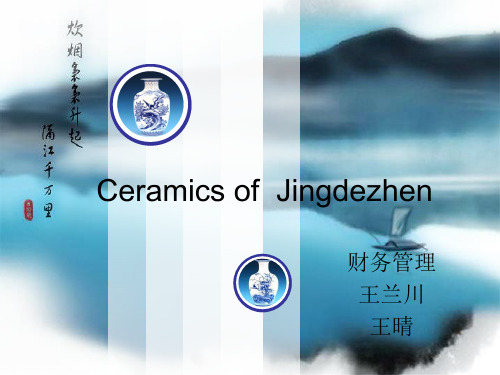
Color-Glazed Porcelain
Famille Rose Porcelain
Rice-Pattern Decorated Porcelain
• Generations in Jingdezhen have always been proud of handicrafts for over one thousand years. It is unprecedented distinctive artistries created by handicraftsmen thus continues of pioneering and pursuing excellence in Jingdezhen from generation to generation.
• The kaolin village is located in the eastern suburb of Jingdezhen from which the most superior material of ceramics making—Kaolin comes.In 1869 A.D. a German geologist transliterated the Chinese 高岭 into a new English word Kaolin.
Bluish White Porcelain
• Bluiics that represents top standard of ceramic artistry in Song Dynasty,which established Jingdezhen as porcelain capital of the world.
谢 谢 !
Ceramics of Jingdezhen
英语介绍我的家乡江西省景德镇市
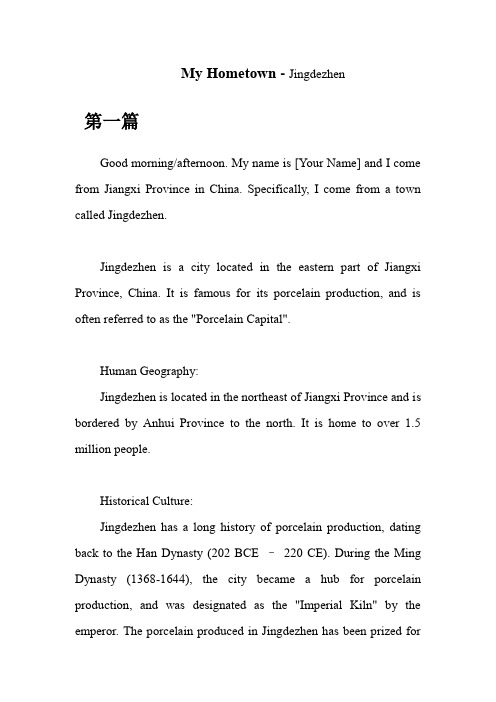
My Hometown -Jingdezhen第一篇Good morning/afternoon. My name is [Your Name] and I come from Jiangxi Province in China. Specifically, I come from a town called Jingdezhen.Jingdezhen is a city located in the eastern part of Jiangxi Province, China. It is famous for its porcelain production, and is often referred to as the "Porcelain Capital".Human Geography:Jingdezhen is located in the northeast of Jiangxi Province and is bordered by Anhui Province to the north. It is home to over 1.5 million people.Historical Culture:Jingdezhen has a long history of porcelain production, dating back to the Han Dynasty (202 BCE –220 CE). During the Ming Dynasty (1368-1644), the city became a hub for porcelain production, and was designated as the "Imperial Kiln" by the emperor. The porcelain produced in Jingdezhen has been prized forits exquisite craftsmanship and artistic beauty, and has been exported around the world.Attractions:Jingdezhen has a number of attractions for tourists. The Jingdezhen Ceramic Museum is a must-see for those interested in porcelain. It features a large collection of porcelain from different dynasties, as well as exhibits on the history of porcelain production in Jingdezhen. The Ancient Kiln Folk Customs Museum is another popular attraction, showcasing the traditional methods of porcelain production. Additionally, the city has a number of temples and historic sites, such as the Taoist temple of Dragon Light Palace and the Ming Dynasty Porcelain Pagoda.Tourism Resources:Apart from its porcelain heritage, Jingdezhen also boasts beautiful natural scenery. Lushan Mountain, located to the south of the city, is a popular destination for hiking and sightseeing. The Yangtze River also flows through the city, providing opportunities for river cruises.Specialty Food:Jingdezhen has a rich culinary tradition, with its own unique local dishes. One of the most famous is Taoxi Meat, a braised pork dish that is traditionally served during festive occasions. Other popular dishes include fish soup, Jingdezhen-style tofu, and fried rice with porcelain shard.Economic Development:Jingdezhen is a developing city, with a growing economy. The city is home to several high-tech industries, including electronic information, biomedicine, and new materials. Additionally, the porcelain industry remains a major contributor to the local economy, with over 100,000 people employed in the industry.Overall, Jingdezhen is a city with a rich cultural heritage, stunning natural scenery, and exciting economic prospects. It is a must-visit destination for those interested in porcelain, history, and Chinese culture.That's all for my introduction of Jingdezhen. If you have any questions about my hometown, feel free to ask me. Thank you!第二篇Jingdezhen, located in the eastern part of Jiangxi Province, is a city with rich cultural and historical significance. The city is known for its porcelain industry and is often referred to as the "Porcelain Capital" of China.As for its human geography, Jingdezhen is surrounded by mountains and rivers, providing a picturesque view. The city has a population of over 1.5 million people and is a mix of different ethnic groups, including Han, Hui, Miao, and Zhuang.Jingdezhen has a long and significant history, dating back over 1,700 years, and is considered one of the birthplaces of ceramic art in China. The city's porcelain industry has been renowned for thousands of years and has played a significant role in shaping the culture and economy of the region.There are numerous famous historical and cultural sites in Jingdezhen, including the Ancient Kiln Folk Customs Museum, the Porcelain Museum, and the Jingdezhen Ceramic History Museum. Additionally, the city has many beautiful temples and pagodas, suchas the Jingdezhen Pagoda and the Taoist Temple of the Five Immortals.Jingdezhen has many tourist resources, such as the Changjiang River National Forest Park, Nine-dragon Cave Scenic Area, and the Dragon Pearl Scenic Area. The city has also developed many high-end hot spring resorts that offer various spa services and scenic views.When it comes to food, Jingdezhen is famous for its local cuisine, including Jingdezhen beef noodles, Jingdezhen fried rice noodles, and Jingdezhen hot pot. These dishes are flavorful and unique, and visitors to the city should make sure to try them.In terms of economic development, Jingdezhen has experienced significant growth in recent years, with the porcelain industry driving much of the city's economy. The city is also known for its furniture and handicraft industries, which contribute to the overall economic growth of the region.Overall, Jingdezhen is a vibrant and culturally rich city with endless tourist attractions and resources. Its unique history,picturesque scenery, and delicious cuisine make it a must-visit destination in China.That's all for my introduction of Jingdezhen. If you have any questions about my hometown, feel free to ask me. Thank you!第三篇Jingdezhen, located in Jiangxi Province, is a renowned city in China for its rich history, culture, and scenic attractions. It is home to a population of over 1.5 million people, and has a diverse geography with mountains, rivers, and lakes.The city boasts a long history dating back to the Han Dynasty, and has been a center for ceramic production since the Tang Dynasty. Its rich cultural heritage is reflected in the numerous temples, museums, and historic sites such as the Ancient Kiln Folk Customs Museum, Jingdezhen Ceramic Museum, and the Imperial Kiln Ruins from the Ming and Qing Dynasties.The city is known for its beautiful scenic spots, such as the Lushan Mountain Scenic Area, Longzhu Lake, and YueliangwanPark. These attractions draw tourists from around the world and contribute to the city's thriving tourism industry. In addition, Jingdezhen is home to many famous porcelain manufacturers and is known as the "Porcelain Capital" of China, making it an ideal destination for those interested in traditional Chinese arts and crafts.Jingdezhen is also famous for its delicious local cuisine, including Steamed Fish Head, Jingdezhen Noodles, and Fish in Sour Soup. These dishes use local ingredients and are prepared according to traditional recipes, offering a unique culinary experience for visitors.In recent years, Jingdezhen has developed rapidly and has become an important economic hub in the region, with industries such as ceramics, tourism, and agriculture contributing to its growth. The city is also home to several colleges and universities, including Jingdezhen Ceramic Institute, which attracts students from around the world to study ceramics and the arts.In summary, Jingdezhen is a city with a rich cultural heritage, breathtaking scenery, and unique local cuisine. Its rapid development and economic growth make it an exciting and dynamic place to visit,and a recommended destination for anyone interested in Chinese history, culture, and art.That's all for my introduction of Jingdezhen. If you have any questions about my hometown, feel free to ask me. Thank you!。
景德镇景点英语作文介绍
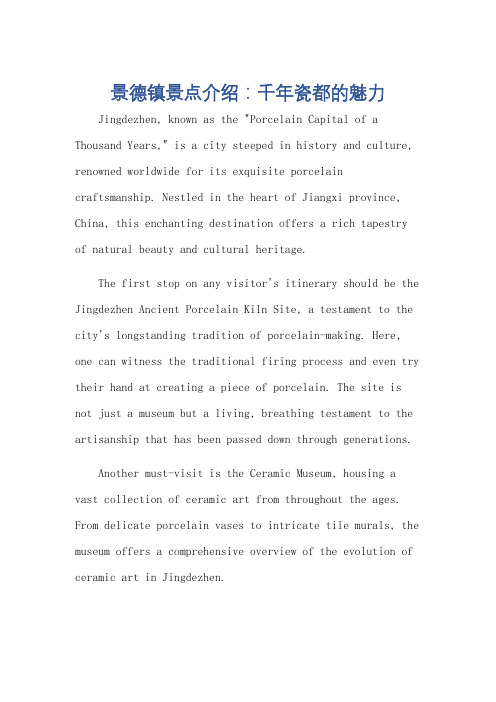
景德镇景点介绍:千年瓷都的魅力Jingdezhen, known as the "Porcelain Capital of a Thousand Years," is a city steeped in history and culture, renowned worldwide for its exquisite porcelain craftsmanship. Nestled in the heart of Jiangxi province, China, this enchanting destination offers a rich tapestry of natural beauty and cultural heritage.The first stop on any visitor's itinerary should be the Jingdezhen Ancient Porcelain Kiln Site, a testament to the city's longstanding tradition of porcelain-making. Here, one can witness the traditional firing process and even try their hand at creating a piece of porcelain. The site is not just a museum but a living, breathing testament to the artisanship that has been passed down through generations. Another must-visit is the Ceramic Museum, housing a vast collection of ceramic art from throughout the ages. From delicate porcelain vases to intricate tile murals, the museum offers a comprehensive overview of the evolution of ceramic art in Jingdezhen.For those seeking a more serene experience, the Lake Gongren is a picturesque destination. Surrounded by lush greenery and serene waters, a stroll along the lakeshore offers a refreshing break from the hustle and bustle of the city.The city's old town, filled with narrow lanes and quaint shops selling all manner of porcelain wares, is a delight for the senses. Here, visitors can bargain for hand-painted porcelain, enjoy local delicacies, and immerse themselves in the daily life of Jingdezhen's residents.For nature lovers, the Wutai Mountain Range offers scenic hikes and breathtaking vistas. Hiking trails lead to ancient temples and pagodas, providing a perfect blend of natural beauty and cultural interest.The evening in Jingdezhen is no less enchanting. The city comes alive with a vibrant night market, where local foods and handcrafts are sold. The sounds and smells of the market create a unique atmosphere that is truly Jingdezhen. In conclusion, Jingdezhen is a city that offers something for everyone. Whether it's the allure of ancient porcelain-making, the serenity of natural landscapes, orthe charm of its old town, Jingdezhen is a destination that should not be missed. With its rich history, vibrant culture, and breathtaking scenery, Jingdezhen is truly a must-visit for anyone interested in Chinese culture and history.**景德镇景点介绍:千年瓷都的魅力**景德镇,被誉为“千年瓷都”,是中国乃至世界著名的瓷器制造中心。
我的家乡景德镇英文作文
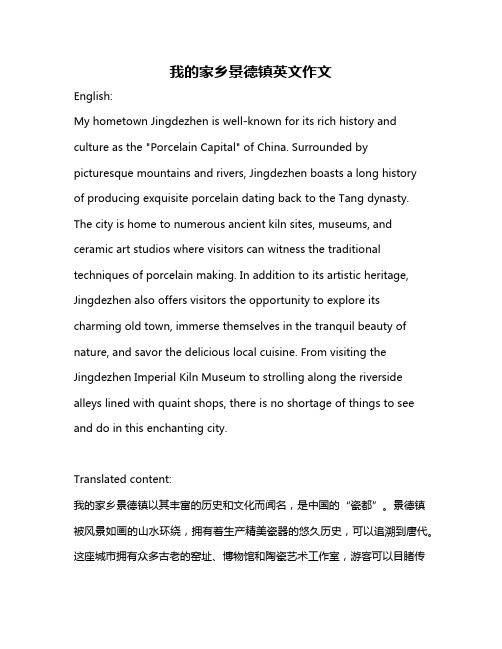
我的家乡景德镇英文作文English:My hometown Jingdezhen is well-known for its rich history and culture as the "Porcelain Capital" of China. Surrounded by picturesque mountains and rivers, Jingdezhen boasts a long historyof producing exquisite porcelain dating back to the Tang dynasty. The city is home to numerous ancient kiln sites, museums, and ceramic art studios where visitors can witness the traditional techniques of porcelain making. In addition to its artistic heritage, Jingdezhen also offers visitors the opportunity to explore its charming old town, immerse themselves in the tranquil beauty of nature, and savor the delicious local cuisine. From visiting the Jingdezhen Imperial Kiln Museum to strolling along the riverside alleys lined with quaint shops, there is no shortage of things to see and do in this enchanting city.Translated content:我的家乡景德镇以其丰富的历史和文化而闻名,是中国的“瓷都”。
我的家乡景德镇英文作文
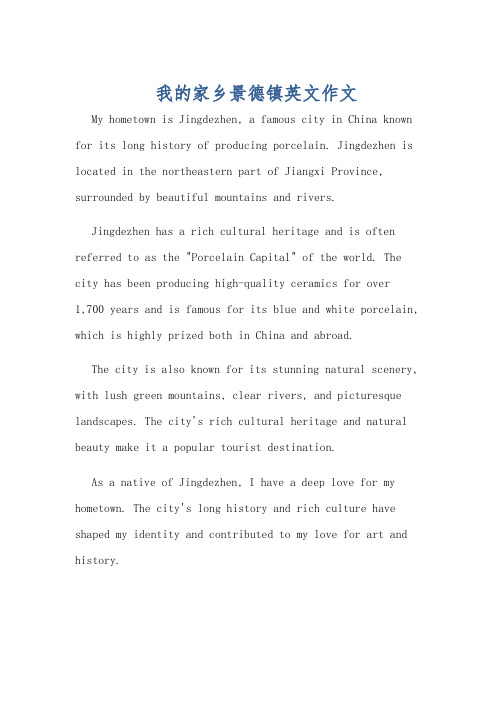
我的家乡景德镇英文作文My hometown is Jingdezhen, a famous city in China known for its long history of producing porcelain. Jingdezhen is located in the northeastern part of Jiangxi Province, surrounded by beautiful mountains and rivers.Jingdezhen has a rich cultural heritage and is often referred to as the "Porcelain Capital" of the world. The city has been producing high-quality ceramics for over1,700 years and is famous for its blue and white porcelain, which is highly prized both in China and abroad.The city is also known for its stunning natural scenery, with lush green mountains, clear rivers, and picturesque landscapes. The city's rich cultural heritage and natural beauty make it a popular tourist destination.As a native of Jingdezhen, I have a deep love for my hometown. The city's long history and rich culture have shaped my identity and contributed to my love for art and history.我的家乡是景德镇,这是中国著名的陶瓷之都,以生产瓷器的悠久历史而闻名。
我的家乡景德镇英文作文
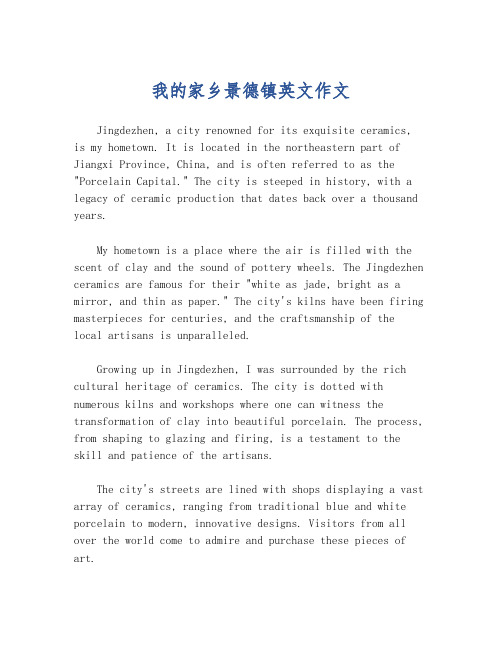
我的家乡景德镇英文作文Jingdezhen, a city renowned for its exquisite ceramics,is my hometown. It is located in the northeastern part of Jiangxi Province, China, and is often referred to as the "Porcelain Capital." The city is steeped in history, with a legacy of ceramic production that dates back over a thousand years.My hometown is a place where the air is filled with the scent of clay and the sound of pottery wheels. The Jingdezhen ceramics are famous for their "white as jade, bright as a mirror, and thin as paper." The city's kilns have been firing masterpieces for centuries, and the craftsmanship of thelocal artisans is unparalleled.Growing up in Jingdezhen, I was surrounded by the rich cultural heritage of ceramics. The city is dotted with numerous kilns and workshops where one can witness the transformation of clay into beautiful porcelain. The process, from shaping to glazing and firing, is a testament to theskill and patience of the artisans.The city's streets are lined with shops displaying a vast array of ceramics, ranging from traditional blue and white porcelain to modern, innovative designs. Visitors from all over the world come to admire and purchase these pieces of art.Jingdezhen is also home to the China Ceramics Museum, which houses a vast collection of ancient and modern ceramics, showcasing the evolution of this art form over the centuries. The museum is a treasure trove for those interested in the history and techniques of Chinese ceramics.Apart from its ceramics, Jingdezhen boasts beautiful natural scenery. The lush greenery and tranquil riversprovide a peaceful backdrop to the bustling kilns and workshops. The city's festivals, such as the International Ceramics Festival, are vibrant celebrations of its cultural identity, attracting artists and enthusiasts from around the globe.Living in Jingdezhen, I have been fortunate to experience the fusion of tradition and innovation. The city's commitment to preserving its ceramic heritage while embracing new ideas and techniques is what makes it a unique and inspiring placeto call home.In conclusion, Jingdezhen is not just my hometown; it isa living museum of ceramic art, a testament to the enduring legacy of Chinese craftsmanship, and a place where the past and future of ceramics are skillfully intertwined.。
向外国人介绍景德镇这个城市英语作文

向外国人介绍景德镇这个城市英语作文Jingdezhen: The Porcelain Capital of the WorldHi there! My name is Xiaoming, and I'm a 10-year-old boy from the city of Jingdezhen in China. Have you ever heard of it? If not, let me tell you all about this amazing place!Jingdezhen is a city in the northeastern part of Jiangxi Province, located along the banks of the beautiful Chang River. It's not a huge city, but it's famous all over the world for one very special thing – porcelain!You see, Jingdezhen has been the center of porcelain production in China for over 1,000 years! That's right, people here have been making the most incredible porcelain pieces since the Tang Dynasty, which was way back in the 7th century. Isn't that incredible?The porcelain made in Jingdezhen is so special because of the unique clay found here. The clay, called "Kaolin," is incredibly fine and pure, and it's what gives Jingdezhen porcelain its famous white color and translucent quality. People say that Jingdezhen porcelain is so thin and delicate that it can almost glow when you hold it up to the light!But porcelain isn't just about the clay – it's also about the incredible skill and artistry of the people who make it. In Jingdezhen, there are entire families who have been porcelain makers for generations. They have passed down their techniques and secrets from parent to child, creating some of the most beautiful and intricate porcelain pieces you've ever seen.One of my favorite parts of living in Jingdezhen is visiting the ancient kilns where porcelain is fired. These kilns are huge, and some of them have been in use for hundreds of years! The porcelain makers carefully load the kilns with their creations, and then they're fired at incredibly high temperatures for days and days. It's like magic watching the plain white pieces transform into gorgeous works of art with colorful glazes and patterns.But you know what I love most about Jingdezhen? The people! Everyone here is so friendly and welcoming, and they're so proud of their city's heritage. Whenever I walk down the street, I can hear the sound of porcelain being painted and glazed in the little workshops that line the alleys. It's like the heartbeat of our city.I hope that one day, you'll have the chance to visit Jingdezhen and see all of its wonders for yourself. Trust me, it's an experience you'll never forget! From the ancient kilns to theskilled artisans, from the beautiful gardens to the delicate porcelain pieces, Jingdezhen is a place like no other.So, what do you say? Are you ready to explore the Porcelain Capital of the World? I'll be waiting to show you around!。
去景德镇旅游作文英语80词
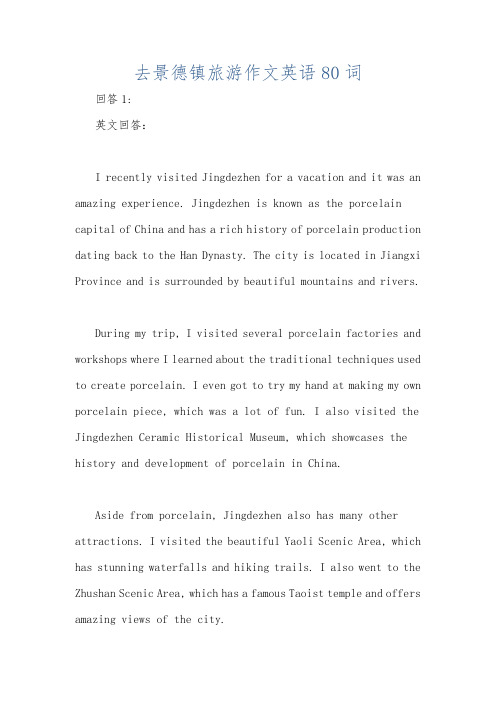
去景德镇旅游作文英语80词回答1:英文回答:I recently visited Jingdezhen for a vacation and it was an amazing experience. Jingdezhen is known as the porcelain capital of China and has a rich history of porcelain production dating back to the Han Dynasty. The city is located in Jiangxi Province and is surrounded by beautiful mountains and rivers.During my trip, I visited several porcelain factories and workshops where I learned about the traditional techniques used to create porcelain. I even got to try my hand at making my own porcelain piece, which was a lot of fun. I also visited the Jingdezhen Ceramic Historical Museum, which showcases the history and development of porcelain in China.Aside from porcelain, Jingdezhen also has many other attractions. I visited the beautiful Yaoli Scenic Area, which has stunning waterfalls and hiking trails. I also went to the Zhushan Scenic Area, which has a famous Taoist temple and offers amazing views of the city.Overall, my trip to Jingdezhen was an unforgettable experience. I highly recommend it to anyone who is interested in Chinese culture, history, and art.中文回答:我最近去了景德镇度假,这是一次非常棒的经历。
景德镇英语介绍作文
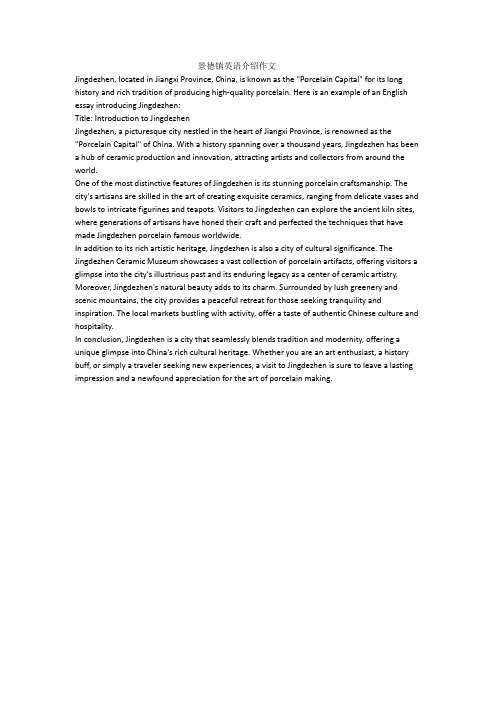
景德镇英语介绍作文Jingdezhen, located in Jiangxi Province, China, is known as the "Porcelain Capital" for its long history and rich tradition of producing high-quality porcelain. Here is an example of an English essay introducing Jingdezhen:Title: Introduction to JingdezhenJingdezhen, a picturesque city nestled in the heart of Jiangxi Province, is renowned as the "Porcelain Capital" of China. With a history spanning over a thousand years, Jingdezhen has been a hub of ceramic production and innovation, attracting artists and collectors from around the world.One of the most distinctive features of Jingdezhen is its stunning porcelain craftsmanship. The city's artisans are skilled in the art of creating exquisite ceramics, ranging from delicate vases and bowls to intricate figurines and teapots. Visitors to Jingdezhen can explore the ancient kiln sites, where generations of artisans have honed their craft and perfected the techniques that have made Jingdezhen porcelain famous worldwide.In addition to its rich artistic heritage, Jingdezhen is also a city of cultural significance. The Jingdezhen Ceramic Museum showcases a vast collection of porcelain artifacts, offering visitors a glimpse into the city's illustrious past and its enduring legacy as a center of ceramic artistry. Moreover, Jingdezhen's natural beauty adds to its charm. Surrounded by lush greenery and scenic mountains, the city provides a peaceful retreat for those seeking tranquility and inspiration. The local markets bustling with activity, offer a taste of authentic Chinese culture and hospitality.In conclusion, Jingdezhen is a city that seamlessly blends tradition and modernity, offering a unique glimpse into China's rich cultural heritage. Whether you are an art enthusiast, a history buff, or simply a traveler seeking new experiences, a visit to Jingdezhen is sure to leave a lasting impression and a newfound appreciation for the art of porcelain making.。
英语作文介绍景德镇
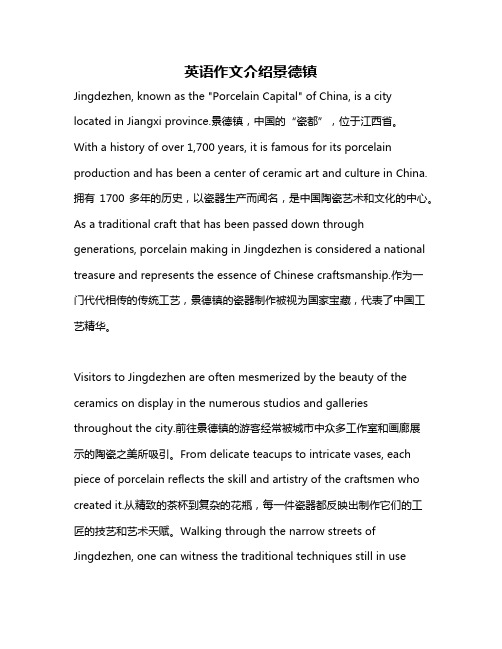
英语作文介绍景德镇Jingdezhen, known as the "Porcelain Capital" of China, is a city located in Jiangxi province.景德镇,中国的“瓷都”,位于江西省。
With a history of over 1,700 years, it is famous for its porcelain production and has been a center of ceramic art and culture in China.拥有1700多年的历史,以瓷器生产而闻名,是中国陶瓷艺术和文化的中心。
As a traditional craft that has been passed down through generations, porcelain making in Jingdezhen is considered a national treasure and represents the essence of Chinese craftsmanship.作为一门代代相传的传统工艺,景德镇的瓷器制作被视为国家宝藏,代表了中国工艺精华。
Visitors to Jingdezhen are often mesmerized by the beauty of the ceramics on display in the numerous studios and galleries throughout the city.前往景德镇的游客经常被城市中众多工作室和画廊展示的陶瓷之美所吸引。
From delicate teacups to intricate vases, each piece of porcelain reflects the skill and artistry of the craftsmen who created it.从精致的茶杯到复杂的花瓶,每一件瓷器都反映出制作它们的工匠的技艺和艺术天赋。
用英语介绍景德镇的作文80词
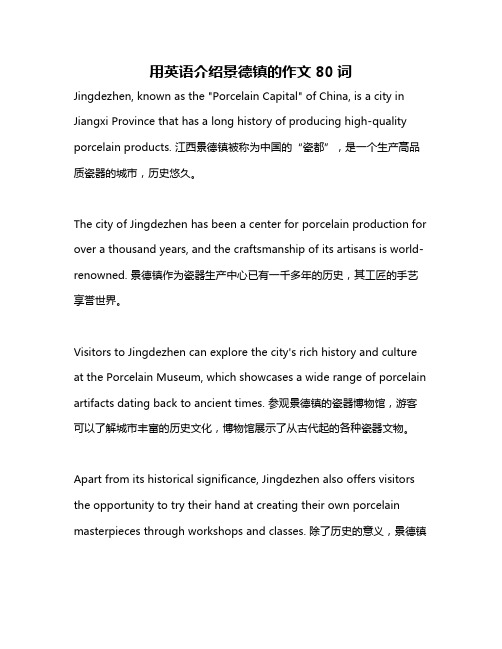
用英语介绍景德镇的作文80词Jingdezhen, known as the "Porcelain Capital" of China, is a city in Jiangxi Province that has a long history of producing high-quality porcelain products. 江西景德镇被称为中国的“瓷都”,是一个生产高品质瓷器的城市,历史悠久。
The city of Jingdezhen has been a center for porcelain production for over a thousand years, and the craftsmanship of its artisans is world-renowned. 景德镇作为瓷器生产中心已有一千多年的历史,其工匠的手艺享誉世界。
Visitors to Jingdezhen can explore the city's rich history and culture at the Porcelain Museum, which showcases a wide range of porcelain artifacts dating back to ancient times. 参观景德镇的瓷器博物馆,游客可以了解城市丰富的历史文化,博物馆展示了从古代起的各种瓷器文物。
Apart from its historical significance, Jingdezhen also offers visitors the opportunity to try their hand at creating their own porcelain masterpieces through workshops and classes. 除了历史的意义,景德镇还为游客提供机会参加瓷器制作的研讨会和课程,亲手体验创作自己的瓷器杰作。
向外国人介绍景德镇这个城市英语作文
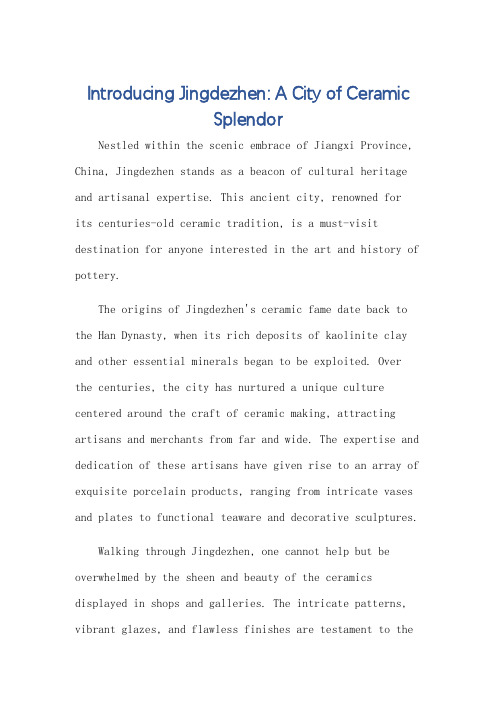
Introducing Jingdezhen: A City of CeramicSplendorNestled within the scenic embrace of Jiangxi Province, China, Jingdezhen stands as a beacon of cultural heritage and artisanal expertise. This ancient city, renowned forits centuries-old ceramic tradition, is a must-visit destination for anyone interested in the art and history of pottery.The origins of Jingdezhen's ceramic fame date back to the Han Dynasty, when its rich deposits of kaolinite clay and other essential minerals began to be exploited. Over the centuries, the city has nurtured a unique culture centered around the craft of ceramic making, attracting artisans and merchants from far and wide. The expertise and dedication of these artisans have given rise to an array of exquisite porcelain products, ranging from intricate vases and plates to functional teaware and decorative sculptures. Walking through Jingdezhen, one cannot help but be overwhelmed by the sheen and beauty of the ceramics displayed in shops and galleries. The intricate patterns, vibrant glazes, and flawless finishes are testament to theskill and patience of the craftsmen. Moreover, the city is home to numerous factories and workshops where visitors can observe the ceramic-making process from start to finish, offering a fascinating insight into the artistry and technology behind these masterpieces.Apart from its ceramic heritage, Jingdezhen also boasts a rich cultural landscape. Ancient temples, pagodas, and historical buildings dot the cityscape, offering a glimpse into its past glory. The Jingdezhen Ceramic Museum is a particularly noteworthy attraction, housing a comprehensive collection of ancient and modern ceramic pieces, providing a comprehensive overview of the city's ceramic history and development.Moreover, Jingdezhen's natural beauty is equally captivating. Surrounded by lush hills and greenery, thecity offers a peaceful and serene setting that complements its cultural attractions. Visitors can enjoy hiking trails, scenic viewpoints, and even tea plantations, providing a refreshing break from the hustle and bustle of city life. For food lovers, Jingdezhen offers a delicious array of local delicacies, many of which are inspired by the city'sceramic culture. Dishes like ceramic pot rice and porcelain chicken are not only delicious but also visually appealing, reflecting the city's unique aesthetic.In conclusion, Jingdezhen is a city that offers aunique blend of cultural heritage, artisanal expertise, and natural beauty. Whether you're an art lover, a history buff, or simply seeking a peaceful getaway, Jingdezhen is sure to captivate and inspire. So, pack your bags and embark on a journey to this captivating city of ceramic splendor.**介绍景德镇:陶瓷艺术的璀璨之城**位于中国江西省风景如画的怀抱之中的景德镇,是一座闪耀着文化遗产与工艺精湛之光的城市。
景德镇介绍(英文版)

back over 2000 years
• Producing porcelain for 1700 years
• One of Chinese Historical and Cultural
Cities
Geography
♥ Located in the northeast of Jiangxi Province ♥ Natural resources include kaolin, coal, lime and manganese
Characteristics
as as as as thin as paper white as jade bright as a mirror sound as a bell
How to make porcelain
1.Select clay with high viscosity, the best is kaolin 2.Mix clay and water, select the fine mud 3.Make ceramic-type tires 4.Dry tires in the shade 5.Trim tires to make them smooth with tools 6.Draw pictures and glazed 7.Roacelain
Species: Blue and white porcelain Colored glaze porcelain Colorful famile - rose porcelain Exquisite porcelain Thin tire porcelain Sculpture porcelain
Education
Jingdezhen Ceramic Institute (JCI) • Established in 1958 • The only institute in China that provides advanced ceramics training • Well-known in Chinese and international academic circles in the field of ceramics
- 1、下载文档前请自行甄别文档内容的完整性,平台不提供额外的编辑、内容补充、找答案等附加服务。
- 2、"仅部分预览"的文档,不可在线预览部分如存在完整性等问题,可反馈申请退款(可完整预览的文档不适用该条件!)。
- 3、如文档侵犯您的权益,请联系客服反馈,我们会尽快为您处理(人工客服工作时间:9:00-18:30)。
Jingdezhen (景德镇, Pinyin: Jǐngdézhèn, or the Town of Jingde), is a prefecture-level city, previously a town, in Jiangxi Province, China, with a total population of 1,554,000 (2007).It is known as the "Porcelain Capital" because it has been producing quality pottery for 1700 years. The city has a well-documented history that stretches back over 2000 years. Jingdezhen is one of Chinese Historical and Cultural Cities, and was named one outstanding civilization & health city of Jiangxi Province, one tourist city of China by the end of 2007.GeographyJingdezhen is situated in the north-east of Jiangxi Province of China and neighbours Anhui; the city center area is located in the north-east of the Poyang Lake Plain. Its area is 5,256 km².[1]The highest point is 1,618 metres, with plains on the southern part with an average height of 200 metres.There are some cities and counties between Jiangxi and Anhui Province around Jingdezhen. To its north, northwest and northeast are Dongzhi, Xiuning and Qimen County of Anhui Province. To its south are Wannian County and Yiyang County. To its west is Boyang County. Lastly, to its southeast are Wuyuan County and Dexing County-level City of Jiangxi Province.Jingdezhen's natural resources include kaolin, coal, manganese, and lime, but it is the kaolin that has made the city famous in China and the world.For over a millennium, its unique kaolin has enabled Jingdezhen to make high-quality porcelain. (The word "Kaolin" came from "Gaoling" or "Kaoling", a village located in Ehu Town, Fuliang County, Jingdezhen City.)Jingdezhen has a subtropical monsoon climate, with four distinct seasons of a year. It is cool and comfortable in spring and autumn, very hot in summer with the extreme maximum temperature of above 40 degrees celsius, and very cold in winter with the extreme minimum temperature of below -5 degrees Celsius.EconomyJingdezhen is not only a major city, but is also a important industrial and commercial base in north-eastern Jiangxi. In 2008, Jingdezhen achieved a GDP of RMB32.2 billion yuan. The city’s per capita GDP ranks fifth among the eleven administrative regions of Jiangxi Province. The per capita disposable income of the urban residents is RMB13,583 yuan; per capita net rural income is RMB5253 yuan. Both of these rank fourth in Jiangxi. Local fiscal revenue was RMB18.5 billion, putting the cityin tenth place, just above Yingtan City. Jingdezhen's GDP and local fiscal revenues are relatively low for Jiangxi Province, but the growth rate is fast. The growth rate of the per capita data is in the middle for the province. [10]Industry The French SA 321 Super Frelon, which Changhe produces under license as the Z-8There are some important industrial enterprises in Jingdezhen City, such as Changhe Aircraft Industries Corporation; Jingdezhen Ceramics; Jingdezhen Refrigeration Compressor, etc.TransportationJingdezhen is the most important transportation hub in the northeast region of Jiangxi province. Historically, Jingdezhen's main communication route was via the Chang River. It could ship its porcelain down the Chang to Poyang Lake and connected there with the Yangtze River in Hukou County, Jiangxi Province. From there the porcelain could get to the coast for export. Today, water is far less important for transporting goods. Roads, the railway and airlines have grown to be more important forms of transport of goods and people.Local transitThere was only one bus line in Jingdezhen before the 1980s, which was from Huang-ni-tou to Nan-men-tou with a total line distance of 7 kilometers. In that time , the city had no taxi service and the buses were channel-type bus, it could carry more than one hundred passengers at most at the same time. This kinds of buses were renewed when they were operated to the end of 1990s.Currently,Jingdezhen public buses and taxis are the two main means of transportation within the city. Nearly more than 20 public bus lines crisscross the city and its countryside. Taxis in Jingdezhen are plentiful; fares start at ¥5 for the first 2 kilometers.EducationJingdezhen city has three colleges or universities, and these have a total of 38,613 students and 1,306 teachers in 2007. It is also the home of the Jingdezhen Ceramic Institute (JCI), which was established in 1958. It is the only institute in China that provides advanced ceramics training and it is also well-known in Chinese and international academic circles in the field of ceramics. The other two institutions of higher educationin the city are the Jiangxi Ceramics & Art Institute and Jingdezhen College.In the city proper there are 47 high schools, called Middle Schools, with 37,200 students and 2,953 teachers. The No.1 Middle School of Jingdezhen was founded in 1940. It is famous for its success rate, relative to other schools in Jiangxi Province, in placing its students in Chinese colleges.There are also 74 primary schools in the city with 40,000 students and 1,884 teachers.Public healthJingdezhen has more than 20 medical service institutions with a total 2182 beds. Doctors and nurses number 2,672. It has the largest hospital system in the north-east of Jiangxi Province. The No.1, No.2 and No.3 People's Hospital of Jingdezhen are the most important hospitals in the city; the No.4 People's Hospital is a psychiatric hospital.Tourism and local customHuizhou architecture (Anhui Province) in Yaoli town, Fuliang county[edit] Travel OverviewJingdezhen is a major tourism destination in northern Jiangxi Province. Most of the city's tourist attractions have a link to the ceramics for which it is famous.[2] The city also provides access to nearby popular tourist areas such as Lushan, Huangshan, and Wuyuan.In 2007, Jingdezhen City earned RMB3.027 billion yuan in revenues from tourism. Tourism accounted for 11.2% of local GDP, up from its share in 2006. The number of visitors is also rising year by year as the city's transportation links to the rest of China improve.At present, Jingdezhen has the most tourist hotels of any city in Jiangxi Province. In the city there is one quasi-five-star hotel, two four-star hotels, and many three-star and other common grade hotels.Jingdezhen is located in Huangshan, Huai Yu Shan Mountains and the Poyang Lake Plain transition zone, both Chinese and foreign famous porcelain, and Foshan, Hankou, zhuxianzhen adding four famous towns, JingdezhenChina State Council announced the first 24 historical and cultural city A one and open city. By 2007, Jingdezhen has received excellent tourist city in China, the National Ecological Garden City, National Civilized Sanitary City, Jiangxi Province civilized Advanced City and so on.Over the past Jingdezhen porcelain is world famous, but now has been not so famous Jingdezhen ceramics提到江西,大家是不是马上就想到了景德镇的陶瓷?上海世博会江西馆就充分利用了这一闻名遐迩的“特产”,将外形设计成青花瓷容器。
